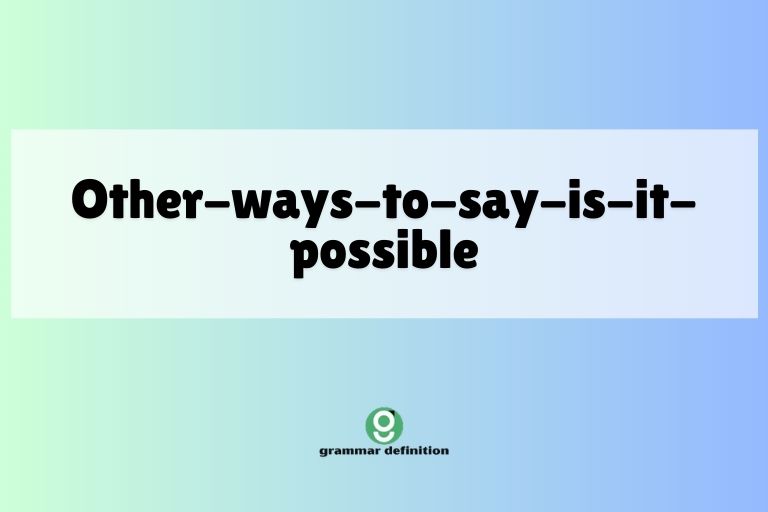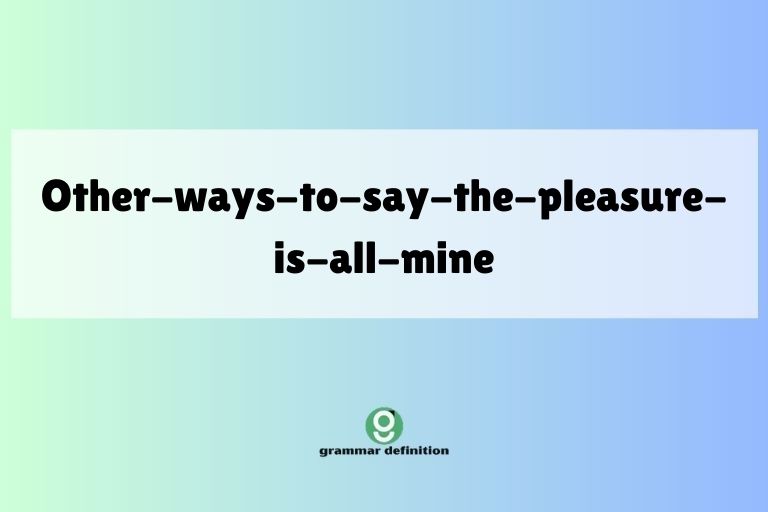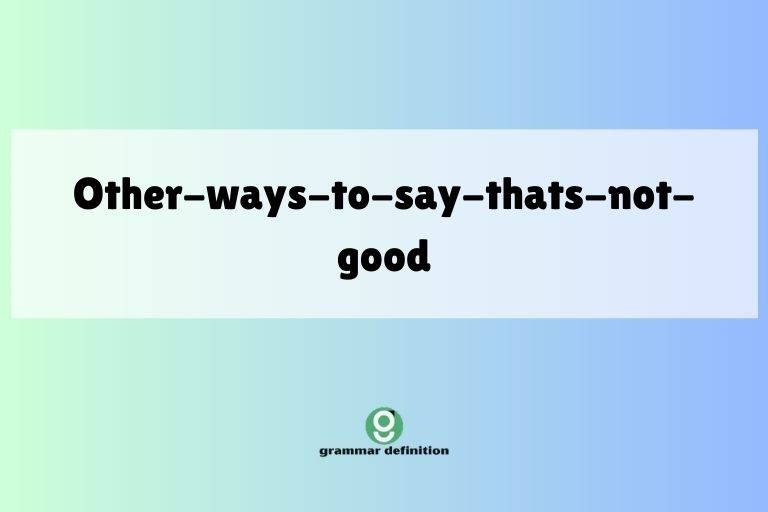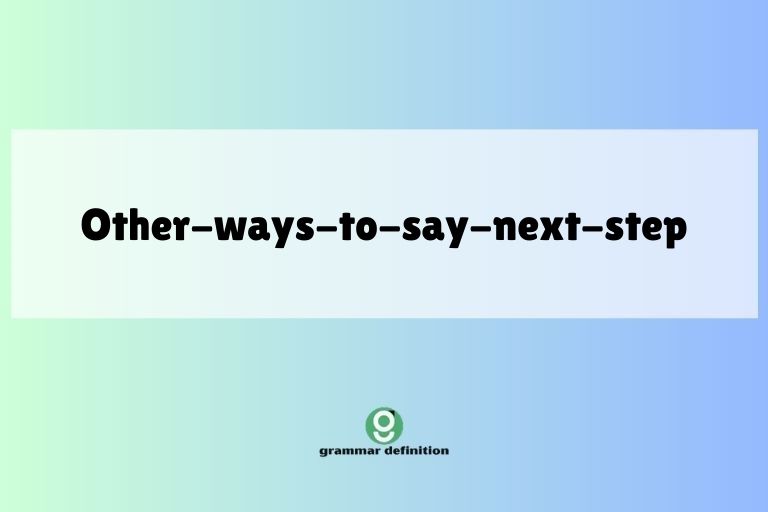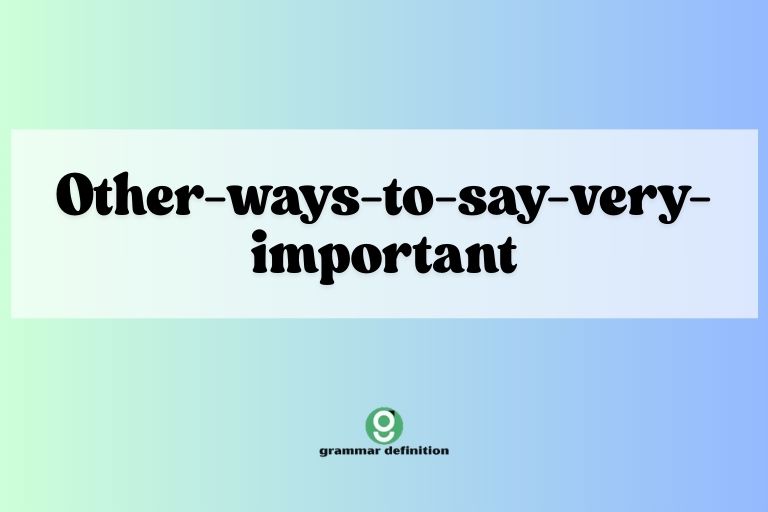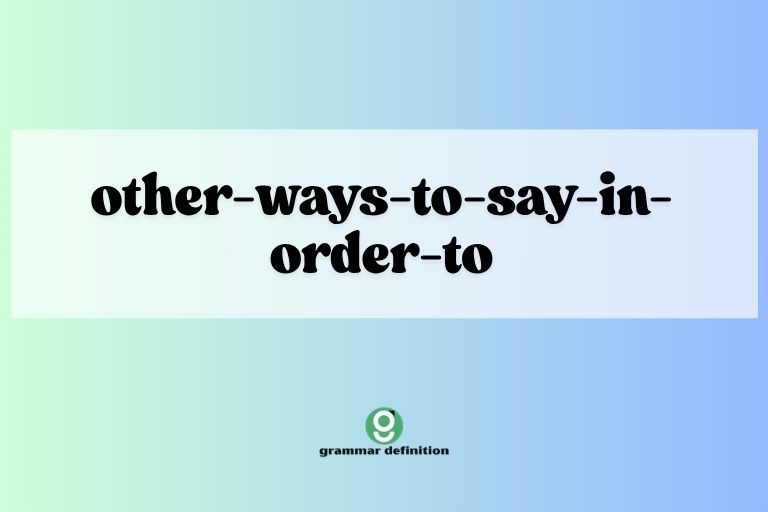Beyond “Just to Confirm”: Diverse Ways to Ensure Understanding
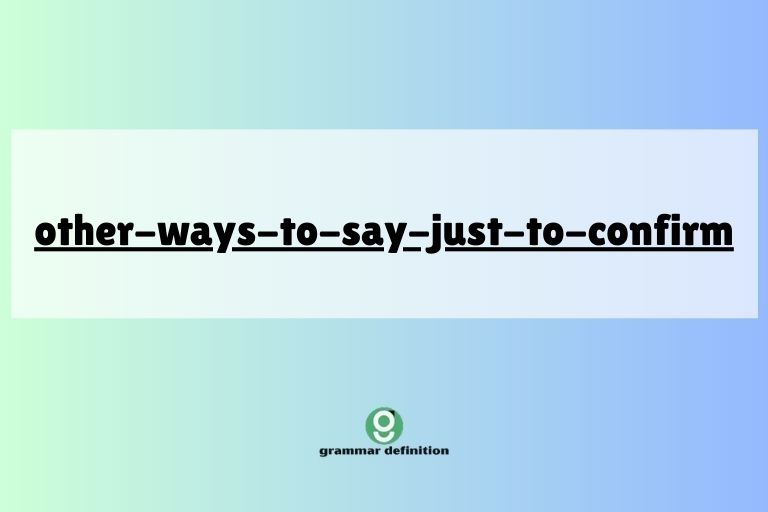
Effective communication hinges on ensuring that messages are not only delivered but also accurately received and understood. While the phrase “just to confirm” is a common way to verify understanding, relying solely on it can make your language sound repetitive and less engaging.
This article explores a wide array of alternative phrases and expressions that you can use to achieve the same goal with greater nuance and clarity. Whether you are writing an email, leading a meeting, or engaging in a casual conversation, mastering these alternatives will enhance your communication skills and make you sound more articulate and professional.
This guide is beneficial for English language learners, professionals seeking to refine their communication strategies, and anyone aiming to diversify their vocabulary.
Table of Contents
- Introduction
- Defining Confirmation and Its Importance
- Structural Breakdown of Confirmation Phrases
- Types and Categories of Confirmation Phrases
- Examples of Alternative Phrases
- Usage Rules and Considerations
- Common Mistakes to Avoid
- Practice Exercises
- Advanced Topics in Confirmation
- Frequently Asked Questions
- Conclusion
Defining Confirmation and Its Importance
Confirmation, in the context of communication, is the act of verifying or validating information, agreements, or understandings to ensure accuracy and mutual comprehension. It involves seeking assurance that a message has been correctly received and interpreted by the recipient. The importance of confirmation cannot be overstated, as it directly impacts the effectiveness of communication, the prevention of errors, and the overall success of interactions, whether in personal, academic, or professional settings.
Effective confirmation helps to prevent misinterpretations and misunderstandings that can lead to mistakes, delays, and conflicts. By actively seeking confirmation, individuals can identify and correct any discrepancies in understanding before they escalate into larger problems.
This proactive approach fosters a culture of clarity and accountability, promoting smoother operations and stronger relationships.
Confirmation is crucial in various contexts. In business, confirming details of a contract, order, or project ensures that all parties are on the same page and reduces the risk of costly errors.
In healthcare, confirming patient information, treatment plans, and medication dosages is vital for patient safety. In education, confirming instructions, deadlines, and expectations helps students succeed.
Ultimately, confirmation is a fundamental element of effective communication that facilitates understanding, reduces errors, and promotes successful interactions in all aspects of life.
Structural Breakdown of Confirmation Phrases
Confirmation phrases can be broken down into several key structural elements that contribute to their overall function and effectiveness. Understanding these elements helps in constructing clear and concise confirmation requests.
The main components include:
- Interrogative Words: Words like “is,” “are,” “do,” “does,” “have,” “has,” “can,” “could,” “will,” “would,” “did,” and “whether” are often used to form questions that seek confirmation. These words initiate the question and guide the listener to respond with a confirmation or denial.
- Subject and Verb Agreement: Ensuring that the subject and verb agree in number and tense is crucial for grammatical correctness. For example, “Are you available?” is correct, while “Is you available?” is incorrect.
- Auxiliary Verbs: Auxiliary verbs, such as “be,” “do,” and “have,” are used in conjunction with main verbs to form questions, negations, and different tenses. They play a key role in constructing grammatically sound confirmation requests.
- Tag Questions: Tag questions are short questions added to the end of a declarative statement. They typically consist of an auxiliary verb and a pronoun that agree with the subject and verb of the statement. For example, “You’re coming tomorrow, aren’t you?”
- Summarizing Phrases: These phrases recap the main points of a discussion or agreement and then ask for confirmation. They often include words like “so,” “therefore,” “in summary,” or “to recap.”
- Clarification Requests: Phrases that directly seek clarification often use interrogative words like “what,” “how,” “when,” “where,” and “why.” They can be used to confirm specific details or aspects of a message.
By understanding these structural elements, you can craft a variety of confirmation phrases that are both grammatically correct and effective in ensuring mutual understanding. Paying attention to these components will also help you avoid common errors and communicate more clearly and confidently.
Types and Categories of Confirmation Phrases
There are several types and categories of phrases you can use instead of “just to confirm,” each serving a slightly different purpose and suitable for various contexts. Here’s a breakdown:
Direct Questions
Direct questions are straightforward inquiries that seek a simple “yes” or “no” answer, or a brief confirmation of a specific detail. They are clear, concise, and leave no room for ambiguity, making them ideal for situations where you need a quick and definitive response.
Indirect Questions
Indirect questions are phrased in a more polite or formal manner than direct questions. They are often embedded within a statement or request, making them less abrupt and more suitable for professional or sensitive situations.
They provide a softer approach to seeking confirmation.
Declarative Statements with Tag Questions
Declarative statements with tag questions involve making a statement followed by a short question at the end, inviting the listener to confirm the statement. This approach is less assertive than direct questions and encourages engagement from the listener.
Tag questions can also add a conversational tone.
Summarizing Phrases
Summarizing phrases involve restating the key points of a discussion or agreement and then asking for confirmation that the summary is accurate. This method ensures that everyone is on the same page and helps to identify any misunderstandings.
Summarizing phrases are particularly useful in meetings or complex discussions.
Phrases Requesting Clarification
These phrases directly ask for clarification on specific points that may be unclear or ambiguous. They help to ensure that you have a complete and accurate understanding of the information being conveyed.
Clarification requests are essential for preventing errors and misunderstandings.
Statements of Understanding
Statements of understanding involve expressing your interpretation of the information and then seeking confirmation that your understanding is correct. This approach demonstrates active listening and encourages the speaker to validate your interpretation.
It is particularly useful in complex or nuanced discussions.
Examples of Alternative Phrases
Here are numerous examples of alternative phrases to “just to confirm,” categorized by type, to help you diversify your communication style.
Direct Questions Examples
Direct questions are the most straightforward way to seek confirmation. The following table provides various examples, each designed to elicit a clear and concise response.
| Direct Question | Context |
|---|---|
| Is that correct? | Verifying a statement or fact. |
| Am I understanding you correctly? | Ensuring comprehension of a speaker’s message. |
| Are we in agreement? | Confirming consensus on a decision or plan. |
| Do you concur? | Seeking agreement on a proposal or idea (formal). |
| Did I get that right? | Checking if you accurately understood something. |
| Have I missed anything? | Ensuring no important details were overlooked. |
| Can you confirm that? | Requesting validation of a specific piece of information. |
| Will that work for you? | Checking if a proposed solution or arrangement is acceptable. |
| Is this the final version? | Confirming the status of a document or product. |
| Are you available tomorrow? | Checking someone’s availability for a meeting or task. |
| Does that make sense? | Ensuring clarity and understanding. |
| Is everything clear? | Checking for any remaining questions or confusion. |
| Are you happy with the result? | Gauging satisfaction with an outcome. |
| Do you agree with this approach? | Seeking alignment on a particular strategy. |
| Did you receive my email? | Confirming receipt of a message. |
| Have you completed the task? | Checking the status of a project. |
| Can you see my screen? | Ensuring visibility during a presentation or online meeting. |
| Are you on the call? | Verifying attendance in a conference call. |
| Do we have a deal? | Confirming an agreement or transaction. |
| Is that your understanding as well? | Seeking confirmation of shared understanding. |
| Are we good to go? | Checking readiness to proceed. |
| Do you have any objections? | Seeking any opposition or concerns. |
| Is this acceptable? | Checking if something meets the required standards. |
| Did you understand the instructions? | Ensuring comprehension of directions. |
| Are you sure about that? | Seeking reassurance on a decision or statement. |
Indirect Questions Examples
Indirect questions offer a more subtle way to seek confirmation, often preferred in professional settings. The following table illustrates various indirect questions along with their appropriate contexts.
| Indirect Question | Context |
|---|---|
| I wanted to check if you received the documents. | Politely inquiring about the receipt of important files. |
| I’m just checking whether the meeting is still scheduled for tomorrow. | Confirming the date and time of a meeting. |
| I was wondering if you could confirm the delivery address. | Seeking confirmation of a shipping address. |
| Could you let me know if you agree with these terms? | Requesting confirmation of agreement to specific conditions. |
| I’d like to verify that we’re all on the same page regarding the budget. | Ensuring shared understanding of financial constraints. |
| I thought I’d ask if you had any questions about the proposal. | Offering an opportunity for clarification on a suggestion. |
| I’m just clarifying if you’re happy with the current progress. | Checking satisfaction with the ongoing work. |
| I’d appreciate it if you could confirm your attendance. | Requesting confirmation of presence at an event. |
| I wanted to see if you had any feedback on the design. | Seeking opinions or suggestions on a creative work. |
| Could you please confirm that the payment has been processed? | Checking the status of a financial transaction. |
| I’m just double-checking that the report is due next Friday. | Confirming the deadline for a submission. |
| I was hoping you could confirm the details of the agreement. | Seeking validation of the specifics of a contract. |
| I’d be grateful if you could verify the accuracy of this data. | Requesting confirmation of the correctness of information. |
| I’m just making sure that we’re aligned on the project goals. | Ensuring mutual understanding of objectives. |
| I thought I’d check if you had any concerns. | Offering an opportunity to express worries or doubts. |
| I’m just verifying that the changes have been implemented. | Checking if modifications have been made. |
| I wanted to ask if you’re comfortable with this approach. | Seeking confirmation of ease with a particular method. |
| Could you please confirm that you’ve read the instructions? | Checking if directions have been reviewed. |
| I’m just double-checking that the system is functioning correctly. | Confirming the operational status of a system. |
| I thought I’d verify that you’re aware of the deadline. | Ensuring knowledge of a time constraint. |
| I wanted to make sure that you received the updated schedule. | Confirming the receipt of a revised timetable. |
| Could you please confirm that you’re available for a call tomorrow? | Checking availability for a phone conversation. |
| I’m just verifying that the software is up to date. | Confirming that the software is current. |
| I thought I’d ask if you had any questions about the new policy. | Offering an opportunity for clarification on a new regulation. |
| I wanted to check whether you’re satisfied with the service. | Confirming contentment with the provided service. |
Declarative Statements with Tag Questions Examples
Declarative statements with tag questions are a conversational way to seek confirmation. They invite the listener to agree with your statement, making the interaction more engaging.
Here are some examples:
| Declarative Statement with Tag Question | Context |
|---|---|
| The meeting is at 2 PM, isn’t it? | Confirming the time of a meeting. |
| You’ll be there, won’t you? | Checking someone’s attendance at an event. |
| You received the email, didn’t you? | Confirming receipt of a message. |
| The deadline is tomorrow, isn’t it? | Verifying the due date of a task. |
| We’re all in agreement, aren’t we? | Ensuring consensus on a decision. |
| You’re handling the presentation, aren’t you? | Confirming who is responsible for a task. |
| The report is finished, isn’t it? | Checking the status of a document. |
| You understand the instructions, don’t you? | Ensuring comprehension of directions. |
| We’re on track, aren’t we? | Confirming that progress is being made as planned. |
| You’ve reviewed the document, haven’t you? | Checking if a file has been examined. |
| The system is working now, isn’t it? | Confirming the operational status of a system. |
| You’re comfortable with this approach, aren’t you? | Seeking confirmation of ease with a particular method. |
| We’re all set for tomorrow, aren’t we? | Checking readiness for an upcoming event. |
| You’ve completed the task, haven’t you? | Confirming the completion of a project. |
| The payment has been processed, hasn’t it? | Checking the status of a financial transaction. |
| You’re aware of the changes, aren’t you? | Ensuring knowledge of modifications. |
| We’re aligned on the goals, aren’t we? | Ensuring mutual understanding of objectives. |
| You’re available for the call, aren’t you? | Checking availability for a phone conversation. |
| The software is up to date, isn’t it? | Confirming that the software is current. |
| We’re satisfied with the service, aren’t we? | Confirming contentment with the provided service. |
| You’ve seen the updated schedule, haven’t you? | Confirming the receipt of a revised timetable. |
| We’re still on for lunch, aren’t we? | Checking if a lunch appointment is still scheduled. |
| You’re happy with the results, aren’t you? | Confirming satisfaction with the outcomes. |
| We’re all clear on the next steps, aren’t we? | Ensuring everyone understands the upcoming actions. |
| You agree with this assessment, don’t you? | Seeking agreement on an evaluation. |
Summarizing Phrases Examples
Summarizing phrases are excellent for ensuring everyone has the same understanding of a complex discussion. They involve restating the main points and then seeking confirmation.
Here are several examples:
| Summarizing Phrase | Context |
|---|---|
| So, to recap, we’re moving forward with the new strategy? | Confirming the decision to implement a new approach. |
| In summary, we’ve agreed to postpone the deadline? | Verifying the agreement to extend the due date. |
| Therefore, we’re allocating more resources to this project? | Confirming the decision to increase investment in a project. |
| To summarize, the budget has been approved? | Ensuring that the financial plan has been officially accepted. |
| In short, we’re proceeding with the merger? | Confirming the decision to continue with a business combination. |
| So, our next step is to contact the client? | Verifying the immediate action to be taken. |
| To recap, everyone is responsible for their own tasks? | Confirming the distribution of duties. |
| In summary, the changes will be implemented by Friday? | Ensuring the timeline for modifications is clear. |
| Therefore, we’re expecting the report next week? | Confirming the anticipated delivery date of a document. |
| So, we’re all aligned on the project goals? | Ensuring mutual understanding of objectives. |
| To recap, the training session is scheduled for next month? | Verifying the date of a learning event. |
| In summary, the new policy will take effect immediately? | Ensuring the effective date of a new regulation is clear. |
| Therefore, we’re expecting full compliance with the new guidelines? | Confirming the requirement to adhere to the new rules. |
| So, we’re all in agreement on the proposed solution? | Ensuring consensus on a suggested resolution. |
| To recap, we’re postponing the launch until further notice? | Verifying the delay of an event. |
| In summary, the decision has been made to downsize the team? | Confirming the difficult choice to reduce the workforce. |
| Therefore, we’re offering severance packages to affected employees? | Confirming the compensation provided to departing staff. |
| So, we’re re-evaluating our marketing strategy? | Verifying the decision to reassess a promotional plan. |
| To recap, we’re focusing on customer retention? | Confirming the emphasis on maintaining existing clients. |
| In summary, the project is on track for completion? | Ensuring that progress is being made as planned. |
| Therefore, we’re not anticipating any delays? | Confirming the expectation of timely completion. |
| So, we’re all clear on our individual responsibilities? | Ensuring that everyone understands their specific duties. |
| To recap, we’re meeting again next week to discuss progress? | Verifying the schedule for a follow-up meeting. |
| In summary, we’ve addressed all the key concerns? | Ensuring that all important issues have been resolved. |
| Therefore, we can move forward with confidence? | Confirming the ability to proceed with assurance. |
Phrases Requesting Clarification Examples
When something is unclear, directly asking for clarification is essential. These phrases help ensure you understand the details accurately.
Here are some examples:
| Phrase Requesting Clarification | Context |
|---|---|
| Could you elaborate on that? | Requesting more detail on a specific point. |
| Can you clarify what you mean by…? | Seeking a clearer explanation of a term or concept. |
| What exactly do you mean by…? | Directly asking for the intended meaning of a statement. |
| Could you be more specific? | Requesting more precise details. |
| Can you give me an example? | Asking for an illustration to aid understanding. |
| I’m not sure I follow. Could you explain it differently? | Admitting confusion and requesting a new explanation. |
| What are the implications of that? | Asking about the consequences or effects of a decision. |
| Could you break that down for me? | Requesting a complex topic to be simplified. |
| What’s the timeline for this? | Asking about the schedule for a project or task. |
| How does this affect our current strategy? | Asking about the impact on the existing plan. |
| Can you provide more context? | Requesting additional background information. |
| What are the key differences between…? | Asking for a comparison of two or more items. |
| Could you walk me through the process? | Requesting a step-by-step explanation. |
| What are the potential risks? | Asking about possible negative outcomes. |
| Can you show me how this works? | Requesting a demonstration of a system or tool. |
| What resources are available for this? | Asking about the support and tools that can be used. |
| How will we measure success? | Asking about the metrics for evaluating performance. |
| What are the alternatives? | Asking about other options or solutions. |
| Could you clarify the next steps? | Requesting a clear understanding of the upcoming actions. |
| What’s the budget for this project? | Asking about the financial resources allocated. |
| Can you explain the reasoning behind this decision? | Requesting the rationale for a choice. |
| What are the long-term goals? | Asking about the overall objectives. |
| How does this align with our mission? | Asking about the connection to the organization’s purpose. |
| What are the potential challenges? | Asking about possible obstacles or difficulties. |
| Can you provide more details on the implementation? | Requesting more information about the execution. |
Statements of Understanding Examples
Expressing your understanding and seeking confirmation is a proactive way to ensure alignment. These statements show you’re actively listening and engaged.
Here are some examples:
| Statement of Understanding | Context |
|---|---|
| So, if I understand correctly, you’re saying…? | Summarizing a speaker’s point to ensure comprehension. |
| It sounds like you’re suggesting…? | Interpreting a speaker’s proposal and seeking validation. |
| Are you saying that…? | Paraphrasing a speaker’s statement for confirmation. |
| If I’m hearing you right, you want us to…? | Expressing your interpretation of a request or instruction. |
| So, your main concern is…? | Identifying the primary issue and seeking agreement. |
| It seems like you’re suggesting we prioritize…? | Interpreting a recommendation and asking for confirmation. |
| Are you proposing that we…? | Paraphrasing a suggestion and seeking validation. |
| If I understand correctly, this will result in…? | Expressing your understanding of the outcome of a decision. |
| So, the key takeaway is…? | Identifying the main point and seeking agreement. |
| It sounds like you’re advocating for…? | Interpreting a speaker’s support for a particular approach. |
| Are you implying that…? | Paraphrasing an indirect statement and seeking clarification. |
| If I’m following you correctly, the next step is…? | Expressing your understanding of the upcoming actions. |
| So, your recommendation is to…? | Interpreting a suggestion and seeking validation. |
| It seems like you’re emphasizing the importance of…? | Identifying the key focus and seeking agreement. |
| Are you highlighting the need for…? | Paraphrasing a speaker’s emphasis and seeking confirmation. |
| If I understand correctly, this will require…? | Expressing your understanding of the necessary resources. |
| So, the main objective is to…? | Identifying the primary goal and seeking agreement. |
| It sounds like you’re suggesting we re-evaluate…? | Interpreting a recommendation to reassess something. |
| Are you proposing that we consider…? | Paraphrasing a suggestion to think about something. |
| If I’m hearing you right, you’re suggesting a change in…? | Expressing your interpretation of a proposed modification. |
| So, the core issue revolves around…? | Identifying the central problem and seeking agreement. |
| It seems like you’re advocating for a more collaborative approach? | Interpreting a speaker’s support for teamwork. |
| Are you highlighting the potential benefits of…? | Paraphrasing a speaker’s emphasis on advantages. |
| If I understand correctly, this strategy aims to…? | Expressing understanding of a strategy’s purpose. |
| So, the primary focus should be on…? | Identifying the main area of attention and seeking agreement. |
Usage Rules and Considerations
Using confirmation phrases effectively requires attention to several rules and considerations. These guidelines will help you communicate clearly and avoid misunderstandings.
- Context Matters: The choice of phrase should align with the context of the conversation. Formal settings may require more polite and indirect questions, while informal settings allow for more direct inquiries.
- Audience Awareness: Consider your audience when selecting a confirmation phrase. Use language that is appropriate for their level of understanding and familiarity with the topic.
- Clarity and Conciseness: Ensure that your confirmation phrase is clear, concise, and easy to understand. Avoid using jargon or overly complex language that could confuse the listener.
- Tone of Voice: Your tone of voice can significantly impact how your confirmation phrase is received. Speak in a calm, respectful, and non-accusatory manner.
- Active Listening: Pay attention to the speaker’s response and adjust your approach as needed. If they seem unsure or confused, provide additional clarification or rephrase your question.
- Avoid Leading Questions: Frame your confirmation phrase in a neutral way that does not suggest a desired answer. This will encourage the speaker to provide an honest and accurate response.
- Cultural Sensitivity: Be mindful of cultural differences in communication styles. Some cultures may prefer indirect communication, while others may value directness.
By following these usage rules and considerations, you can ensure that your confirmation phrases are effective in promoting clear communication and preventing misunderstandings. Practicing these guidelines will help you become a more confident and skilled communicator.
Common Mistakes to Avoid
Even with a solid understanding of confirmation phrases, it’s easy to make mistakes. Here are some common errors to watch out for:
- Overusing “Just to Confirm”: Relying too heavily on this phrase can make your communication sound repetitive and uninspired. Vary your language to keep your conversations engaging.
- Using Leading Questions: Framing questions in a way that suggests a desired answer can bias the response and lead to inaccurate confirmation.
- Ignoring Nonverbal Cues: Failing to pay attention to the speaker’s facial expressions, body language, and tone of voice can cause you to miss important cues about their understanding.
- Assuming Understanding: Don’t assume that the other person understands just because they nod or say “yes.” Proactively seek confirmation to ensure mutual comprehension.
- Using Ambiguous Language: Vague or unclear language can lead to misinterpretations and undermine the effectiveness of your confirmation efforts.
Here are some examples of correct and incorrect usage:
| Incorrect | Correct | Explanation |
|---|---|---|
| Just to confirm, you agree, right? | Do you agree? | The “right?” is unnecessary and leading. |
| Just to confirm, you understood everything? | Is everything clear? | More concise and less accusatory. |
| Just to confirm, you’ll do it, okay? | Can you confirm that you will do it? | More polite and professional. |
| Just to confirm, you know what to do? | Are you familiar with the procedure? | Clearer and less condescending. |
| Just to confirm, you got it? | Do you understand the instructions? | More formal and explicit. |
Practice Exercises
Test your understanding with these practice exercises. Each exercise focuses on different aspects of using alternative confirmation phrases.
Exercise 1: Rewriting “Just to Confirm”
Rewrite the following sentences, replacing “just to confirm” with a more appropriate alternative phrase.
- Just to confirm, the meeting is at 3 PM?
- Just to confirm, you received the document?
- Just to confirm, you agree with the plan?
- Just to confirm
, you will attend the training session?
- Just to confirm, the deadline is next Friday?
Exercise 2: Identifying Appropriate Phrases
For each scenario, choose the most appropriate confirmation phrase from the options provided.
- Scenario: You need to verify that a client received an important contract.
Options:- Did you get that?
- I wanted to check if you received the contract.
- So, you got the contract?
- Scenario: You want to ensure that your team is aligned on the project goals.
Options:- You know what to do, right?
- Are we all on the same page regarding the project goals?
- Goals are clear?
- Scenario: You need to verify the delivery address with a supplier.
Options:- Address is correct?
- Could you please confirm the delivery address?
- You got the address right?
Exercise 3: Creating Confirmation Phrases
Create your own confirmation phrase for each of the following situations:
- Verifying a client’s payment details.
- Confirming a team member’s availability for a meeting.
- Ensuring a colleague understands the new company policy.
Advanced Topics in Confirmation
Beyond basic confirmation, there are advanced techniques that can enhance your communication effectiveness. These include:
- Strategic Questioning: Using a series of well-crafted questions to guide the speaker towards confirming key points.
- Mirroring: Reflecting back the speaker’s words or tone to show empathy and encourage them to elaborate.
- Emotional Intelligence: Recognizing and responding to the speaker’s emotions to build rapport and trust.
- Conflict Resolution: Using confirmation techniques to de-escalate conflicts and find common ground.
- Cross-Cultural Communication: Adapting your confirmation style to suit different cultural norms and expectations.
Mastering these advanced topics can significantly improve your ability to ensure understanding and build stronger relationships.
Frequently Asked Questions
Why is it important to use alternatives to “just to confirm”?
Using a variety of phrases makes your communication more engaging and less repetitive. It also allows you to tailor your language to different contexts and audiences, improving clarity and effectiveness.
How do I choose the right confirmation phrase?
Consider the context of the conversation, your audience, and the specific information you need to confirm. Choose a phrase that is clear, concise, and appropriate for the situation.
What if the other person still doesn’t understand?
Try rephrasing your confirmation phrase or providing additional clarification. Use examples or visual aids to help them understand the information more clearly.
How can I improve my active listening skills?
Pay attention to the speaker’s words, tone of voice, and body language. Ask clarifying questions and summarize their points to ensure you understand their message accurately.
Is it okay to use “just to confirm” sometimes?
Yes, it’s perfectly acceptable to use “just to confirm” occasionally. However, avoid overusing it to keep your communication fresh and engaging.
Conclusion
Mastering alternative phrases to “just to confirm” is a valuable skill that can significantly enhance your communication effectiveness. By diversifying your language and paying attention to context, audience, and tone, you can ensure clear understanding, prevent misunderstandings, and build stronger relationships.
Whether you are writing emails, leading meetings, or engaging in everyday conversations, the techniques outlined in this article will help you communicate with greater confidence and clarity. Embrace these strategies and elevate your communication skills to the next level.

